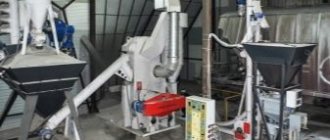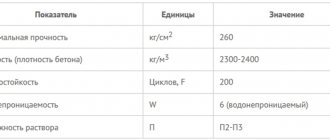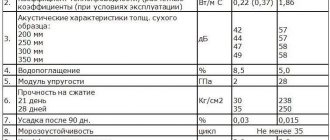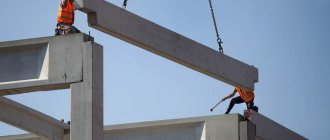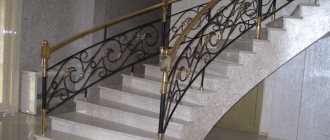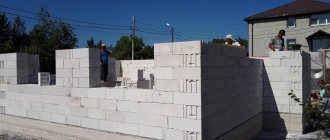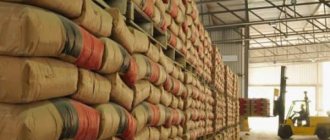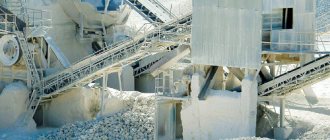B15 concrete has sufficient strength to create load-bearing structures. Its widespread use is explained by the fact that the properties it possesses are sufficient for the manufacture of any structures, from pouring monolithic foundations, screeding floors and paths. Reliable operation of this material is ensured by strict compliance with regulatory requirements for the composition and quality of the components used for its manufacture. A good level of strength and durability at a relatively low cost is the main advantage over other brands.
2 Normative references
This standard uses normative references to the following interstate standards:
GOST 4.212-80 System of product quality indicators. Construction. Concrete. Nomenclature of indicators
GOST 5578-94 Crushed stone and sand from ferrous and non-ferrous metallurgy slags for concrete. Specifications
GOST 7473-2010 Concrete mixtures. Specifications
GOST 8267-93 Crushed stone and gravel from dense rocks for construction work. Specifications
GOST 8269.1-97 Crushed stone and gravel from dense rocks and industrial waste for construction work. Chemical analysis methods
GOST 8735-88 Sand for construction work. Test methods
GOST 8736-2014 Sand for construction work. Specifications
GOST 10060-2012 Concrete. Methods for determining frost resistance
GOST 10178-85 Portland cement and Portland slag cement. Specifications
GOST 10180-2012 Concrete. Methods for determining strength using control samples
GOST 12730.1-78 Concrete. Methods for determining density
GOST 12730.5-84 Concrete. Methods for determining water resistance
GOST 13015-2012 Concrete and reinforced concrete products for construction. General technical requirements. Rules for acceptance, labeling, transportation and storage
GOST 13087-81 Concrete. Methods for determining abrasion
GOST 17623-87 Concrete. Radioisotope method for determining average density
GOST 17624-2012 Concrete. Ultrasonic method for determining strength
GOST 18105-2010 Concrete. Rules for monitoring and assessing strength
GOST 22266-2013 Sulfate-resistant cements. Specifications
GOST 22690-2015 Concrete. Determination of strength by mechanical methods of non-destructive testing
GOST 22783-77 Concrete. Method for accelerated determination of compressive strength
GOST 23732-2011 Water for concrete and mortars. Specifications
GOST 24211-2008 Additives for concrete and mortars. General technical conditions
GOST 24316-80 Concrete. Method for determining heat generation during hardening
GOST 24452-80 Concrete. Methods for determining prismatic strength, elastic modulus and Poisson's ratio
GOST 24544-81 Concrete. Methods for determining shrinkage and creep deformations
GOST 24545-81 Concrete. Endurance Test Methods
GOST 25192-2012 Concrete. Classification and general technical requirements
GOST 25592-91 Ash and slag mixtures from thermal power plants for concrete. Specifications
GOST 25818-2017 Fly ash from thermal power plants for concrete. Specifications
GOST 26644-85 Crushed stone and sand from thermal power plant slag for concrete. Specifications
GOST 27006-86 Concrete. Squad selection rules
GOST 27751-2014 Reliability of building structures and foundations. Basic provisions
GOST 28570-90 Concrete. Methods for determining strength using samples taken from structures
GOST 29167-91 Concrete. Methods for determining crack resistance characteristics (fracture toughness) under static loading
GOST 30108-94 Construction materials and products. Determination of specific effective activity of natural radionuclides
GOST 31108-2016 General construction cements. Specifications
GOST 31384-2017 Protection of concrete and reinforced concrete structures from corrosion. General technical conditions
GOST 31424-2010 Non-metallic construction materials from screenings of crushing dense rocks in the production of crushed stone. Specifications
GOST 31914-2012 High-strength, heavy and fine-grained concrete for monolithic structures. Rules for quality control and assessment
GOST 32495-2013 Crushed stone, sand and sand-crushed stone mixtures from crushed concrete and reinforced concrete. Specifications
GOST 33174-2014 Public automobile roads. Cement. Technical requirements
GOST ISO/IEC 17025-2009 General requirements for the competence of testing and calibration laboratories
Note - When using this standard, it is advisable to check the validity of the reference standards in the public information system - on the official website of the Federal Agency for Technical Regulation and Metrology on the Internet or using the annual information index "National Standards", which was published as of January 1 of the current year, and on issues of the monthly information index “National Standards” for the current year. If the reference standard is replaced (changed), then when using this standard you should be guided by the replacing (changed) standard. If the reference standard is canceled without replacement, then the provision in which a reference is made to it is applied in the part that does not affect this reference.
Basic definitions and classification of concrete
Before starting construction work, you need to clearly understand what concrete is and how a heavy mixture differs from a fine-grained one. You also need to understand the brands of material and know their designations.
Thus, it is important to know these definitions:
- Concrete is a building material obtained artificially through the process of mixing and further hardening of a specially prepared concrete mixture.
- Heavy concrete is a mixture whose average density is more than 2000−2500 kg/m³, made with cement binder and dense coarse and fine aggregates.
- Fine-grained concrete is a mixture with an average density of more than 2000−2500 kg/m³, made with cement binder and dense fine aggregate.
Thus, the difference between heavy and fine-grained monoliths lies in the aggregates used for their production. So, if aggregate of both coarse and fine fractions is used to produce a heavy concrete mixture, then only the second option is suitable for fine-grained concrete.
The classification of concrete directly depends on the indicators characterizing its quality:
- Strength. This indicator is divided into three classes. Each of them has its own alphabetic and numerical designations: for compression - Latin B with an indicator from 3.5 to 120 (for example, concrete B3.5, B5, B7.5, B20, B25, B90, etc.); for axial tension - Bt from 0.8 to 4.8; for tensile bending - Btb from 1.2 to 10.0.
- Frost resistance. For marking, the Latin letter F with numbers from 50 to 1000 is used. For example, F50, F75, F100, etc.
- Waterproof. For this type of concrete, the letter W and numbers from 2 to 20 are used.
- Abrasion. This indicator is checked on a special circle and the monolith is marked with one of three options - G1, G2, G3.
For each class of monolithic concrete mixture there is a specific brand. For example, in accordance with GOST, grade M200 is produced for B15 concrete. This must be taken into account during construction, because in any project the brand of the mixture used must be indicated. It should be noted that it is best to purchase them at a specialized plant, where they strictly ensure that the quality of heavy concrete complies with GOST.
Content
- 1 area of use
- 2 Normative references
- 3 Terms, definitions, symbols and abbreviations
- 4 General provisions……………………………………………………………………………………………………………………………………….
- 5 Task for selecting the composition of concrete…………………………………………………………………………………………………………….
- 6 Selection of the nominal composition of concrete……………………………………………………………………………………..
- 7 Purpose and adjustment of working compositions of concrete…………………………………………………………………………………
- 8 Transfer of working concrete compositions to production………………………………………………………………………………….
Appendix A (recommended) Form of map for selecting the composition of heavy concrete……………………………..
Appendix B (informative) Development of production compositions of heavy concrete
M M OF (ON
at the concrete mixing unit………………………………………………………………………………..9
Bibliography………………………………………………………………………………………………………………………………………11
Cement
— GOST 310.3-76 Cements. Methods for determining normal density, setting time and uniformity of volume change
Establishes test methods for determining the normal density, setting time of cement paste, as well as the uniformity of changes in the volume of cement.
— GOST 310.4-81 Cements. Methods for determining tensile strength in bending and compression
Establishes test methods for determining flexural and compressive strength.
— GOST 30744-2001 Cements. Test methods using polyfraction sand
Establishes methods for testing cement using polygraded sand.
— GOST 31108-2016 General construction cements. Specifications
Establishes requirements for cements and components of the material composition of these cements.
Scope of application
The use of MB is determined by the absence of open rock deposits with the presence of large fractions in the area where cement-sand mixtures are produced.
Delivery of crushed stone or gravel to remote areas significantly increases the cost of concrete, which affects the cost of the final product. This reason is the most common when deciding to produce concrete using fines.
In addition to purely economic reasons, there are many products and structures that cannot be produced using traditional concrete with large fractions. These include:
- asphalt concrete pavement;
- concrete pipes of large and small diameter;
- structural elements for the construction of hydraulic structures;
- pipes with special properties for draining aggressive water;
- any thin-walled reinforced structures (for example, spherical products are cast from MB, which have high strength and, at the same time, low weight);
- floor slabs for equipping canopies in agricultural buildings where it is necessary to cover large spans;
- bunker structures, large containers for storing bulk and liquid substances and materials;
- products with dense reinforcement;
- arched structures capable of covering large spaces (for example, when equipping exhibition pavilions).
Reinforcement of structures
Most prefabricated structures, and especially monolithic ones, are subject to internal reinforcement to increase their strength characteristics. But before considering this or that GOST for reinforced concrete, we will present to your attention a list of materials used as reinforcement, standards for them, and their basic requirements.
Reinforcement of a monolithic structure
Rebar and wire
GOST 10884, adopted back in 1994, according to which smooth and periodic reinforcement is produced, has been edited many times, and is valid only until the end of 2022. Then it will be replaced by GOST 34028 * 2016, which will come into force from 01/01/2018.
Reinforcement is classified according to mechanical properties and performance characteristics. In the first case, this is a strength class that expresses the value of the yield strength of steel. In the second, this is a division into reinforcement C (weldable) and K (corrosion-resistant).
The standard contains the main dimensions and parameters, technical requirements for manufacturing and profiling, marking, and quality control methods. Rules for transportation, acceptance and storage.
Wire for reinforced concrete reinforcement is made from cold-drawn low-carbon steel in accordance with GOST 6727-80, which is still in force today. It presents the technical requirements for its manufacture, test methods, marking and acceptance rules.Attention! General purpose wire, which is used for tying reinforcement, is manufactured in accordance with GOST 3282-74.
Welded products from reinforcement
Standard 10922*2012 regulates the production of reinforcing and embedded products for reinforced concrete structures, as well as their mechanical connections. According to this GOST, all types of reinforcement connections must be made during the manufacturing of monolithic and prefabricated structures and their installation: mechanical, welding, knitting.
It also establishes general technical requirements for products made from reinforcing bars and wire with a diameter of 3 mm or more. GOST does not apply only to embedded parts that do not have anchoring rods.
The document defines 4 types of products:
- Individual rods with prepared joints at the ends.
Individual reinforcement bars with prepared connections
- Reinforcing mesh.
Welded mesh for reinforced concrete concrete
- Frames made of reinforcement.
Frame for reinforced concrete structure
- Embedded parts with anchor rods.
Embedded elements with anchor rods
Grids, which are most often used when pouring slab structures with your own hands, are flat and rolled, with rectangular and square cells, with the working reinforcement located in one or two directions. Rolled mesh is made from wire with a diameter of up to 5 mm. Technical conditions for the production of meshes and their classification are defined in a separate standard 23279*2012.
The frames can be flat and spatial, made of rods of the same or different diameters. In spatial frames, the rods are located in different planes. Embedded parts can be open and closed, with different locations of anchor rods relative to the flat element.
Depending on the location of the anchor rods relative to the flat element, embedded products with perpendicular, inclined, parallel or mixed arrangement of anchor rods are distinguished. The types of such parts are given in a special appendix.
Welded connections of reinforcement, carried out both in the factory and on site, must structurally comply with the requirements of standard 14098.
Advantages
The use of fine-grained concrete is due to its unique properties. This material has many advantages compared to traditional solutions:
- increased resistance to bending moment under appropriate load;
- the ability to obtain unique properties using additional additives (for example, acid resistance or water resistance);
- increased resistance to vibration;
- homogeneity of the mixture;
- the ability to use various options for pouring complex elements and structures;
- high plasticity of the solution and excellent penetrating ability.
Table of characteristics of concrete mixtures
| Class | Brand | Euro class | Mobility | Strength | Waterproof | Frost resistance | Rigidity |
| AT 10 | M150 | c8/10 | P2 - P4 | 163 kg/cm2 | W2 - W4 | F 50 | Zh1 – Zh4 |
| B15 | M200 | s12/15 | P2 - P4 | 196 kg/cm2 | W2 - W4 | F 100 | Zh1 – Zh4 |
| IN 20 | M250 | s16/20 | P2 - P4 | 275 kg/cm2 | W4 - W6 | F 150 | Zh1 – Zh4 |
| B22.5 | M300 | s18/22 | P2 - P4 | 296 kg/cm2 | W6 | F 200 | Zh2 - Zh4 |
| B25 | M350 | s20/25 | P2 - P4 | 337 kg/cm2 | W6 - W8 | F 200 | Zh2 - Zh4 |
| B30 | M400 | s25/30 | P3 - P5 | 392 kg/cm2 | W10 | F 300 | Zh3 - Zh4 |
| B35 | M450 | s30/37 | P3 - P5 | 458 kg/cm2 | W10 - W12 | F 200 - F300 | Zh3 - Zh4 |
| B40 | M550 | s32/40 | P3 - P5 | 524 kg/cm2 | W10 - W16 | F200 - F300 | Zh3 - Zh4 |
| B45 | M600 | s35/45 | P4 - P5 | 591 kg/cm2 | W12 - W18 | F200 - F400 | Zh3 - Zh4 |
